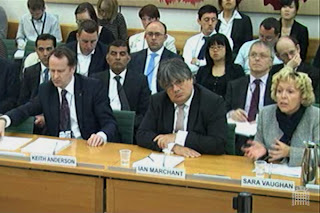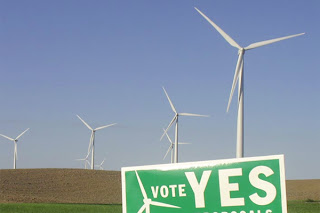 |
| Actual (blue) and needed greenhouse gas emissions for the UK. The Committee says they only began declining again in the last year by coincidence. Click for larger version. |
It says that despite greenhouse gas emissions falling by 7% last year, only 0.8% of this fall was due to Government policy. The rest happened because of coincidental factors which cannot be relied upon to meet targets.
“Much of last year’s fall in emissions was due to a combination of mild weather, rising fuel prices, falling incomes and transitory factors in power generation," said David Kennedy, Chief Executive of the CCC. "But as the economy recovers it will be difficult to keep the country on track to meet carbon budgets. We need to tackle major challenges to drive emissions down across the economy – and to do this as a matter of urgency.”
Yesterday, Energy Minister Charles Hendry was celebrating apparent progress in decarbonising the UK grid, as his department issued its quarterly energy statistics. He said they showed "a clear increase on the first quarter of last year across all renewables, with rises in wind, hydro, solar and bioenergy generation.
“Alongside a 36% increase in renewables capacity in the last 12 months, this shows that the UK is powering forward on clean and secure energy and is clearly a very attractive place to invest,” he said.
The latest energy statistics do record progress, with onshore wind generation increasing by 51% and offshore by 51% in the first quarter of 2012, and the high amount of rainfall helped to boost hydroelectric generation by 43%. In 2011, renewable heat sources increased by 5% but still only accounted for around 2.2% of total heat demand.
This is good news but not good enough for the Committee.
In reducing emissions, decarbonising the power sector is only part of the picture. Nevertheless, the report complains that investment in wind generation in 2011 was just one third of the rate required annually to achieve the target by the end of the decade.
It says that a total of £8 billion is required to support low carbon generation by 2020-21, which would satisfy a shopping list of one new nuclear reactor, four CCS demonstration projects, 15GW of onshore and 12GW of offshore wind, plus a mix of other renewables.
The important figure for the statistics comes in terms of measuring progress towards the 2020 target of deriving 15% of all energy from renewable sources, as specified under the 2009 Renewable Energy Directive. The provisional figures show that during 2011, just 3.8% of final energy consumption was from renewable sources. This is an increase from the revised 2010 figure of 3.2%, and 3.0% in 2009.
Although there is plenty of potential new wind generation in the pipeline, the Committee says that “delivering investments will require resolution of current policy uncertainties, and that financing barriers are addressed".
Most urgently it wants to see support levels confirmed under the Renewables Obligation. Then there must be a major role for the Green Investment Bank in mobilising project finance for offshore wind investment. The Government also needs to work with its EU partners to strengthen the carbon price within the EU emissions trading scheme.
The Committee is furthermore concerned at the lack of progress on carbon capture and storage (CCS). It warns that projects must be selected and funding awarded this year, with construction starting by 2014.
It recommends further incentives: to increase uptake particularly of cavity wall and loft insulation in the Green Deal and the Energy Company Obligation, to support renewable heat in the residential sector, and to address market barriers such as households not having confidence in or enough information about renewable heat technologies.
It advises retaining the Carbon Reduction Commitment, but with a reduced administrative burden and a redesigned league table to strengthen reputational incentives.
There should be a Green Deal for the non-residential sector in place by the end of the year and ambitious standards for private rented regulation in the non-residential sector by the end of 2013.
It also wants to see, in the forthcoming industry strategy, approaches set out to increase the use of sustainable bioenergy in large industry.
Transport
Renewable biofuels for transport actually fell by 7% (to 1,127 ktoe), comprising just 3.5% by volume of road transport fuels in 2011.
In this sector, the Committee wants to see more incentives to encourage the reduction of emissions from new vans, an increase in the electric vehicle market, and a reversal of the decision on company car tax relief for electric vehicles which George Osborne made in the last budget.
In the Budget 2012 George Osborne announced that company car tax exemption for electric vehicles would be withdrawn from 2015/16. This decision, the Committee says, will not raise significant revenue, given the low sales of electric vehicles, but it will undermine incentives for purchase of electric company cars, a market niche where there is a potentially high share of early adopters.
Interestingly, the Committee proposes that driving tests should include standards for driving fuel-efficiently, and wants to see the current motorway speed limit enforced properly, code for saying do not increase the speed limit.
Agriculture must play its part, the Committee says, and there needs to be a robust framework in place for monitoring changes in farming practice that influence emissions, and by the end of the year a strategy for going beyond the current voluntary approach in the sector to cutting emissions.
The Committee wants to see the electricity market reforms set a clear objective of achieving carbon intensity in power generation of the order of 50gCO2/kWh in 2030. This would "provide investor confidence that there will be a market for low carbon technologies that are built to schedule and cost and that there will not be a second dash for gas".
In conclusion, the Committee issues a stark warning: "when we first highlighted the need for a step change in investment there was a lead-time of several years, but this has now elapsed. Therefore the step change is needed urgently if we are to remain on track to meeting future carbon budgets".










